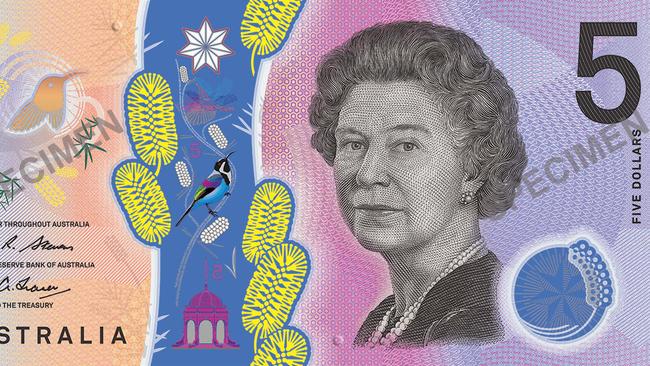What you didn’t know about the new $5 note
LOVE it or hate it, the new $5 note is about to replace more than 165 million old ones. But there’s more to its redesign than meets the eye.

THE birth of a new banknote is a momentous occasion.
I mean, Miley Cyrus was in nappies and Ariana Grande wasn’t even born the last time this happened.
And so it was with great fanfare that the Reserve Bank of Australia unveiled its fancy new $5 note, the product of a determined campaign by blind teenager Connor McLeod.
But the note’s tactile markings, which make it easily recognisable by the vision impaired, are not its only distinguishing feature.
Here are five things you probably didn’t know about the new bank note release — including what happens to all those old $5 bills.
‘WORLD FIRST’ SECURITY
If you’re going to design a new banknote, you’d better make sure it’s protected against counterfeiters.
The new $5 note is bisected by a world-first, clear top-to-bottom window that’s designed to make it harder to copy.
It has dynamic features including a bird flapping its wings and a text that changes colour as the banknote is tilted.
“The new banknotes are the culmination of many years of research and trial and extensive consultation with subject-matter experts and the cash-handling industry, as well as qualitative research involving focus groups,” RBA Governor, Glenn Stevens said.
“The new $5 banknote has a range of security features that have not previously been used on an Australian banknote and that will help to keep our banknotes secure against counterfeiting into the future.”
MORE CHANGES UNDERWAY
The new $5 note is the first in a new series of bank notes, with each of the other denominations set to be upgraded in coming years.
Each new denomination will incorporate the same security and tactile features as the $5 banknote, which has a raised bump on each of the note’s long edges.
And they will each feature a distinct species of Australian wattle and a native bird within “a number of distinctive elements”, the RBA said. The new $5 banknote bears the image of the Prickly Moses wattle and the Eastern Spinebill.
Key features such as colour, size and people portrayed will be kept in order to ensure they are still recognisable.
And, as previous reported by news.com.au, you can still fold your $5 note to make a crude image of a whale appearing to perform a sex act.
NOTES PHASED OUT
While the new $5 note went into circulation yesterday, it could take years before it becomes the prevailing standard.
It all depends on how long it takes for the 165 million or so existing $5 notes to be phased out.
In the meantime, they’re still valid currency — as are the old paper notes your grandparents buried in the backyard.
Michael Andersen, Head of Note Issue at the RBA, said many Australians were unaware of this, especially the younger generations.
“It is still legal tender but we do hear of some stories, where because people don’t remember paper bank notes — especially kids who weren’t born when we had paper bank notes,” Mr Andersen said. “So they’re confused so they end up sending the people to the banks. It’s not that they’re not legal tender, it’s just that people don’t recognise them anymore.”
He said it was hard to predict how long it would take for the old $5 notes to be phased out of existence.
“This is something that’s really a phenomenon for the public,” he said. “If they prefer the new bank notes, then it might be quicker.”
The last big issue of new bank notes was in 1992, when the RBA introduced the plastic notes that are commonplace today. Within a few short years, they replaced about 80 per cent of notes in circulation.
“But you’ve got to remember that was a move from paper to polymer, so it might’ve been a bit quicker then,” Mr Andersen said.
“It could be a while until the polymer notes come back to us, because they’re obviously more durable ... We will issue only new notes, as demand increases and also as unfit notes come back to us and are destroyed.”
WHERE CURRENCY GOES TO DIE
You may have been wondering, what happens to all those old banknotes anyway? The answer is the stuff of Mehajer wedding dreams.
“Old bank notes are shredded into confetti-like pieces then passed through a machine that melts them and turns them into pellets,” the RBA said in a statement.
“Those pellets can be recycled into building components, plumbing fittings, compost bins and other products.”
But before you get too excited at the prospect of raining shredded currency down on your nuptials, there are strict security protocols around the destruction of currency.
One of the reasons for this, is that the RBA operates a damaged note facility where members of the public can return notes that are badly damaged, and receive cash compensation.
“We’ll assess its value and honour the amount that we assess it to be,” Mr Andersen said. “So if we’re handing out confetti, there’s a chance that they could present that to us.”
MARKED FOR DESTRUCTION
Banknotes are only destroyed once they meet the RBA definition of being unfit for use.
“There’s a very technical definition for it but it’s things like the level of ink wear on the bank note, folded corners, holes from staples, or graffiti where people have written something on it,” Mr Andersen said.
“There’s a variety of ways they can get damaged, they can just wear over time, from just normal wear and tear, and they also get some mechanical damage — holes, tearing.”
Banks send the worn-out notes to the RBA, where they’re authenticated and assessed as unfit. Then the shredding begins.




